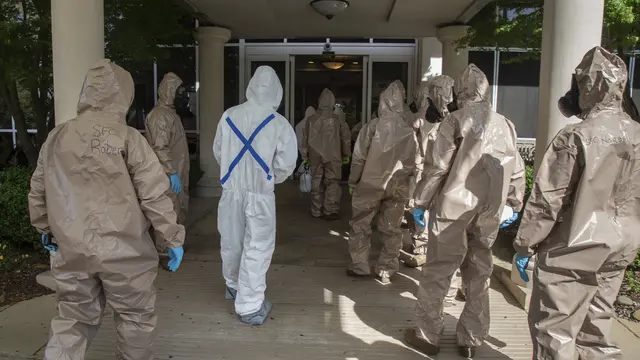
The 265th Infectious Control Georgia Army National Guard enters Canterbury Court, a senior living facility to disinfect the building during the coronavirus outbreak, in Atlanta, U.S., April 10, 2020. /AP
**Editor's Note: **Li Yun is a researcher at the Institute of Foreign Military Research of the Department of War Research, China's People's Liberation Army (PLA) Academy of Military Sciences. The article reflects the author's opinions and not necessarily the views of CGTN.
The U.S. Army, which was not spared by the COVID-19 storm, has been struggling to strike a balance between fighting COVID-19 and ensuring combat readiness.
The Military Times and otherU.S. media outlets recently reportedthatwith the rapid increase in COVID-19 casesin the U.S. Army, the top military officials are having a tough time deciding between ensuring combat readiness and maintaining the health of soldiers.
Epidemic prevention and combat readiness affect each other.
Catering to variousrisk factors, includingthe impact ofnon-traditional securitythreatsonnationalsecurity, is part of themilitary'scombat readiness. At the same time, poor performance against epidemic inevitably affects the troops'fighting capacity.If themilitary cannot guarantee its own security, how can they maintain national security?A case in point here is the influenza pandemicat the end of the World War I. The flu had substantial adverse impacts on the armies ofthe participating countries, including their combat effectiveness.
So far, the U.S.military has poor performance in the battle against COVID-19.Therefore, the U.S.military is now troubledby how to dealwiththerelationship betweencombat readiness andresponse toCOVID-19. The poor performance in fighting against COVID-19 is mainly embodied in two aspects.
Oneis the failure inearly warning and prevention of theCOVID-19 outbreakin the U.S.military. The armies ofallcountrieshave the most advanced intelligence systemsandcanobtainthehighest level ofconfidentialinformationrelatedtovarioussecuritythreatsfromtheir respective national departments.Therefore, the military should have the ability to achieve foresight,early prevention and curb the spread of the disease in military.
At the same time, as an organization with strict discipline, the military can more effectively adopt variousprevention and control measures internally.Of course, the premise isthat themilitary wants to do this, rather than dismiss the officers and soldiers who actively call for epidemic prevention measures.
Obviously, theU.S.military failed to do this.The confirmed cases first appeared in overseas garrisons, then the Pentagon and the domestic garrison were infected, and then the major military exercises, such as Defender Europe 2020, were canceled.
Themost impressive event in the world and in the United Statesis the dismissal ofCaptainBrett Crozierof theUSSTheodore Roosevelt CVN-71.Under the premise of Hollywood blockbuster efforts to promote American heroism around the world, the dismissal ofCrozieris clearly incompatible with the American values promoted by Hollywood blockbusters.
The other isthe U.S. army is not playing a critical role in thenationalfight against COVID-19.

The USNS Comfort arrives in New York to help with the overcrowding at the city's hospitals with COVID-19 patients, March 30, 2020. /AP
The armies of many countries are actively braving the global COVID-19storm.
Admittingandtreatingpatients, developingvaccinesand delivering necessities for the people, theChinese armed forces have been active in all aspects of fighting the epidemic.
The Russian army is not only playing an active part in fighting the epidemic in its own country, but also became the main body providing assistance to foreign countries. Dozens of Russian medical teams went to Italy and Serbia to provide assistance.
In addition, the military forces of Germany, France, Italy and other countries are also actively involvedin the battle against COVID-19 from variousaspects, such aspatient admission, disinfection, epidemic prevention and implementation ofisolationmeasures.
However, the performance of the U.S.military is quite disappointing.Not to mention the late start of U.S.military involvementinthe national fight againstCOVID-19.Of course,the"confident" U.S.President Donald Trump'snationalepidemic preventionmeasuresalsolag behind.
The performance of USNS Comforthospital ship issufficienttoreflect the role of the U.S.army in the fight against the epidemic.After arriving in New York on March 30,the ship at first only admitted diseases except COVID-19 in order to alleviate overcrowding in New York hospitals. Then, inthe next five days in New York,the ship with thousands of hospital bedsonly received20 patients.OnApril7, a crew member of the ship was confirmed with COVID-19.On the same day, the ship announced that it had begun receiving COVID-19patients.Contradictory information about whether the ship has the capacity to treat COVID-19 patients, coupled withthat a specialized hospital ship could not guarantee the security of its own crew, the real role of U.S.militaryin the nationalfight againstCOVID-19can be imagined.
The deeper reason for the poor performance of the U.S.militaryin responsetoCOVID-19 is that the U.S.military failed todeal with the relationship between traditional and non-traditional security threat.
This is one of the dilemmas of the U.S.military's transformation after the Cold War.The deeper reason for this dilemma is that theU.S.military hasamisunderstanding of non-traditional security threats.
The U.S.military mainly understands "non-traditional security threats" as an extension of "traditional security threats" in new combat areas.To be frank, the response to "non-traditional security threats" is an excuse forits continuedexpansion of military preparations and its reliance on military forces to establish and maintain global hegemony.
For that reason, the U.S.military has continuously strengthened its military strength in fields such as network and space, and has used anti-terrorist operations and anti-terrorist wars to interfere internal affairs of other countries and shape the regional pattern.
In this case, the response to strengthen the so-called "non-traditional securitythreatscapacity-building" is onlyto strengthen theability of response to "traditional security threat."The imbalance in the relationship between non-traditional security threats and traditional security threatscannotonlybealleviated, instead it will be expanded further.
One of the bad consequences of the further expansion of this imbalance is that the U.S. military failed to respond to the COVID-19 epidemic effectively, and this imbalance has affected the ability of the U.S. military to respond to "traditional security threats" as well.
(If you want to contribute and have specific expertise, please contact us at [email protected].)
 简体中文
简体中文

